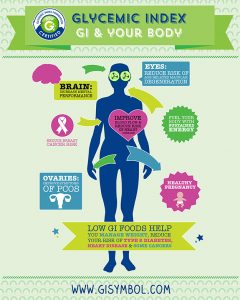 Low Glycemic Index diets and eating plans are currently very popular.
Low Glycemic Index diets and eating plans are currently very popular.
The Glycemic Index ranks carbohydrates on a scale from 0 to 100 according to how they affect blood glucose levels during two hours after eating. It is measured on 50g of actual carbohydrate. For example 50g of glucose has a value of 100.
Carbohydrates with a high GI are quickly broken down and digested, and affect blood glucose levels quickly and dramatically.
Carbohydrates with a low GI are digested and absorbed slowly and affect blood glucose levels gradually, producing gentle rises and falls in blood gucose and insulin levels.
A low GI diet can keep you feeling full longer, can help you lose weight, can help in diabetes and insulin management and avoid sugar highs and lows that drive you to snacking.
Standard ranges for Glycemic Index are:
- Low GI Foods = up to 55
- Medium GI Foods = 56 – 69
- High GI Foods = 70 or more
Foods containing low amounts of carbohydrate, such as meat, fish, eggs, avocado, wine, beer and some vegetables, are therefore not able to have a GI value calculated. Of course, you would probably be eating them for other reasons.
GI can not be determined by analysing the chemical structure, for example if it is a simple or complex carbohydrate. It is only determined by actually measuring the blood glucose response to a group of real people under controlled test conditions.
Glycemic Load (GL)
The Glycemic Index compares foods calculated per gram of carbohydrate. This does not take into account how many grams of carbohydrates are in a single serve of the food. So the Glycemic Load was introduced to measure the glycemic effect of a standard serving.
Glycemic Load = GI x grams of carbohydrate/100
For example, watermelon has a high GI, but the standard serving size has a low GL. And carrots, which famously have a high GI, but are only around 7% carbohydrate, end up with a low GL, as well as containing loads of nutrients. And are a great snack.
Foods are ranked according to Glycemic LOAD as follows:
- Low GL : 10 or less
- Medium GL : 11-19
- High GL : 20 or more
If you add up the Glycemic LOAD for the food you eat over one day, a Low GL would be less than 80. A High GL would be over 120.
The ultimate resource on Glycemic Index is at Glycemic Index, by the Human Nutrition Unit of the University of Sydney, Australia. The website explains how GI is scientifically measured, and contains a searchable database of GI and GL for foods around the world, and is a commercial GI testing centre for new foods.
Jenni Brand-Miller is Associate Professor at the Sydney University Human Nutrition Unit, and the author of The New Glucose Revolution, The New Glucose Revolution LifePlan and related pocket books. Buy them in Australia from Seekbooks.
Low GI Eating
As carbohydrates are the main food affecting blood sugar levels, we need to pay close attention to the carbohydrates in our diets.
Our bodies do need carbohydrates to function, to fuel the brain and provide energy. Therefore active people generally need more carbohydrates. But it is the quality of the carbohydrate that is important.
High carbohydrate foods include grains, fruits, legumes, some vegetables (potatoes, corn) and dairy products. But a low carb diet that excluded these foods because of their high carb content would be ignoring their nutritional value.
Low carbohydrate vegetables include leafy green vegetables and carrots and salads and are generally included in all diets.
Factors that may affect the GI level of a carbohydrate by slowing the rate of digestion include: whole grain structure (physically slows breakdown), large particle size (as in unprocessed foods), high-acidity and fat content (slows stomach emptying). An excellent in-depth analysis of the factors affecting GI are at the Montignac site, which is based around low GI eating.
Just because a food is low GI, does not mean that only those foods should be eaten. High fat foods are often low GI, for example potato chips versus a boiled potato, but filling up on potato chips is an unhealthy way to eat because of the saturated fat content.
Generally around half of the carbohydrates in your diet should be low GI to experience the health benefits.
Simple changes to your diet may involve:
- Look for low GI cereals or porridge
- Choose grainy or sourdough breads
- Use basmati rice, barley, buckwheat, couscous or noodles instead of white rice.
- Try lentils, kidney beans and borlotti beans
- Enjoy fruits and leafy vegetables